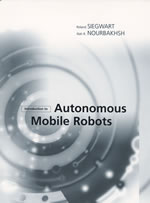

Robotics and autonomous systemsThis course is an advanced course in computer science focusing on the broad, inter-disciplinary field of robotics where the students build and program an autonomous robot.AimAfter the course the student should be able to
SyllabusDuring the course a small, mobile, autonomous robot for performing certain tasks is built. This work is carried out as a project. The participants in the course work in groups on the practical implementation of a specific behaviour of this simple robot by integration of simple mechanisms for perception and action on the robot. At the end of the course there is a contest between the robots that the participants have constructed to assess the strength and weaknesses of different approaches.The theoretical part of the course deals with fundamental concepts in robotics, kinematics and navigation. The practical part of the course includes studies of sensors and control, the construction and programming of a small robot. RequirementsThe requirements for passing the course are
GradingThe grade on the course is given by a holistic overall assessment of the work you performed in the course. The grade will not be the same for all member in the project groups. It is fine if different group member have different leves of ambition, that will always be the case to some extent, you need to discuss this in the group openly.
The project report from each group will be graded after you have received feedback from other students (on the fraft report) and had time to address the comments. The reflection that you prepare for the lectures is intended to guide you towards a good way of learning, to actively work with the material and think about what it is you are reading and how it relates to what you already know. Knowledge becomes much more useful when it is connected between different domains and subject. It is your way of reasoning around the material from your perspective that is important here. Some differences from last yearFor the past 3 years or so we have been using the Eyebot microcontroller. This year we will switch to an FPGA based system designedby Jorge Sanchez de Nova. The new platform will feature about 10 times the processing power and a richer set of sensors. To keep in mind though is that this is the first time the platform is used, and as with all new developments there might be things that need to be adapted. Your feedback is therefore very important during the course.ScheduleWe will try to avoid to much of he normal teacher-speaks, students-listen paradigm and instead discuss the different topics in the book together. One group of students will prepare each chapter and present it during the first 45min of a lecture. We will spend the second half of the lecture to dicuss the material.
Fixed lab hoursThe schedule below shows the date and time of when the lab assistant is scheduled to be in the lab. This is a good time to ask questions.
Important Dates
Course materialThe course book is "Introduction to Autonomous Mobile Robots" by Roland Siegwart and Illah R. Nourbakhsh" published by the MIT Press.
There is a page with the answer to some questions around some of the equations etc in the book to be found here. ContactIf you have any questions regarding the course you can contact
|